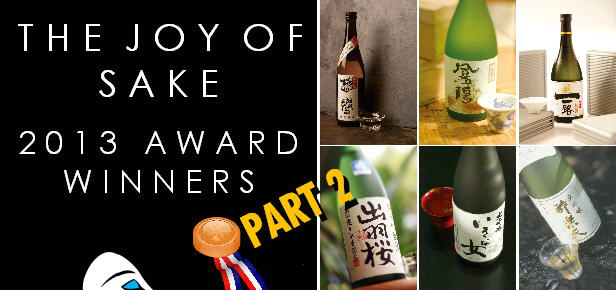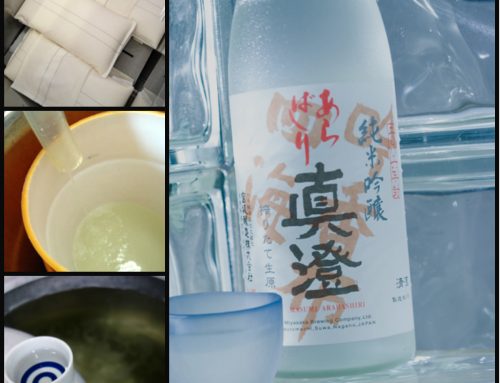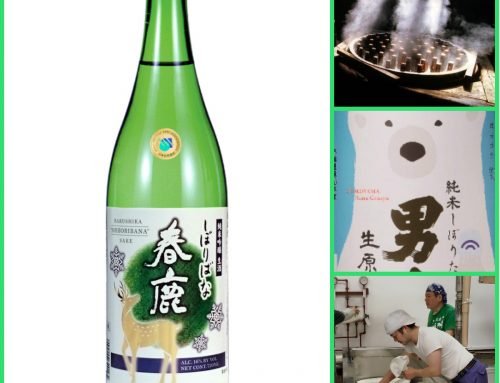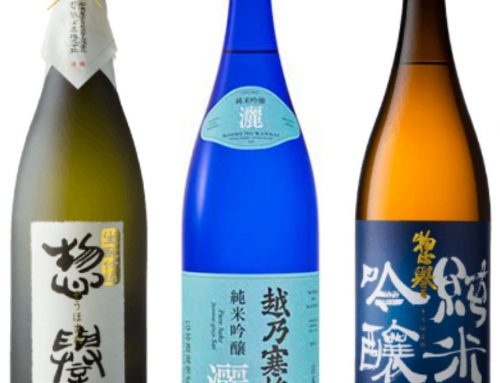JOY OF SAKE 2013 AWARD WINNERS SAKE TASTING PART 2
“WAIT” YOU SAY! Didn’t we already do a Joy of Sake 2013 Award Winners Sake Tasting! Well yes we did, but there were just too many Gold and Silver winners this year to fit into just one tasting. So our friend and sake master, Yoshiharu Suzuki, has graciously agreed to host a SECOND tasting this Saturday which will include an impressive NINE different award winning sake! Included in this tasting are two BRAND NEW TO HAWAII Gold award winners, Sohomare Tokubetsu Junmai Kimoto and Dewazakura Ichiro.
Because they make such great sake, we’ll also be sampling almost the entire Dewazakura line including their high end Daiginjo. All of these sake from Dewazakura are Gold or Silver award winners. Then just for good measure, we’ll finish things off with three more sake from Hoyo, Tedorigawa and one of Nadine’s all time favorites from Akitabare!
Being able to sample NINE different award winning sake is pretty impressive, even to us. This is one of those special tastings you will not want to miss!
JOY OF SAKE 2013
AWARD WINNERS SAKE TASTING PART 2
Saturday, October 26, 2013
2:00pm to 7:30pm

SOHOMARE TOKUBETSU JUNMAI
“Heart and Soul”
JUNMAI KIMOTO
GOLD AWARD WINNER
Brand new to Hawaii and a Gold winner at the recent Joy of Sake 2013/US National Appraisals. Classic rendition of ancient kimoto style (see right column for explanation of kimoto). Soulfully drinkable with plenty of acidity and ample umami, all in perfect harmony.

DEWAZAKURA ICHIRO
“Abbey Road”
JUNMAI DAIGINJO
GOLD AWARD WINNER
Brand new to Hawaii and another Gold winner from the recent Joy of Sake 2013/US National Appraisals. Fresh meadow imprint of flowers and grass billows out into a fuller flavor profile replete with young fruit. A dry gently fading finish rounds the circle. Top-scoring sake entry at the London 2008 International Wine Challenge and one of Malcolm’s new favorites.

DEWAZAKURA DAIGINJO
“Mountain Cherry”
DAIGINJO
GOLD AWARD WINNER
This sake is reminiscent of softly melting snow. It has a mild floral fragrance, revealing notes of peach and apricot at mid-range, concluding with a light and slightly dry finish.

DEWAZAKURA DEWASANSAN
“Green Ridge”
JUNMAI GINJO
SILVER AWARD WINNER
One of our most popular sake from Dewazakura, this sake begins with a floral nose and mellow fruity flavor. “Dewasansan” is a rewarding choice for wine drinkers new the world of sake. It has wholesome freshness, a green apple tartness and a refreshing finish.

DEWAZAKURA OKA
“Cherry Bouquet”
GINJO
GOLD AWARD WINNER
Soft feeling on the tongue, Oka’s transparency of flavor matches the clarity of the colorless liquor. It is floral rather than fruity, though there is a touch of pear and perhaps melon.

DEWAZAKURA OMACHI
“Jewel Brocade”
JUNMAI GINJO
GOLD AWARD WINNER
Made from Omachi rice (see right column for more about this special rice) the ancestral stain from which virtually all sake brewing rices are descended, with a luscious aroma and ornate flavor that deepens and mellows on the palate.

AKITABARE SUIRAKUTEN
“Heaven of Tipsy Delight”
DAIGINJO
SILVER AWARD WINNER
One of Nadine’s all time favorites, this high end premium sake is cold aged in the bottle for two years before release. This unusual practice allows the sake to develop a rarefied, multi-hued flavor. Gentle, yet strong, unassuming but proud, a masterpiece of the brewer’s art.

HOYO KURA NO HANA
“Fair Maiden”
DAIGINJO
SILVER AWARD WINNER
This premium sake is transparently light and touched with a sweet kiss of anise. Hoyo’s winsome grace and charm are irresistible. It’s lovely floral aroma and luscious flavor extend a demure invitation to the world of sake enjoyment.

TEDORIGAWA IKI NA ONNA
“Lady Luck”
DAIGINJO
SILVER AWARD WINNER
Another favorite of Nadine’s, this sake is clean and balanced on one hand, with a caress of wild honey on the other. Iki na Onna is a classy confident sake brewed in very limited amounts for the Association of Lady Sake Retailers.
BIG, BIG sake tasting this Saturday that you won’t want to miss. Hope to see you then!
Kanpai,
Malcolm & Nadine Leong
The Sake Shop
JOY OF SAKE 2013
AWARD WINNERS SAKE TASTING PART 2
Saturday, October 26, 2013
2:00 pm to 7:30 pm

Sohomare Sake Brewery
Sohomare Sake Brewery was established in 1872 by the Kono family and is located in Tochigi prefecture. Brand new to Hawaii and first introduced at this years Joy of Sake event, Sohomare is brewed using the old school Kimoto method.

Mr. Jun Kono
Nadine had the the pleasure of meeting Mr. Jun Kono, the fifth generation President of Sohomare Sake Brewery when he recently dropped by to visit us at the shop.

Dewazakura Sake Brewery
Dewazakura Brewery is located in the snowy Alps of Yamagata prefecture in Northern Japan.
Founded in 1893, Dewazakura is known for producing crisp, aromatic and cleanly balanced sake. The brewery’s sub-zero storage technique make it possible to enjoy their wonderful sake all year round.
Dewazakura is known as the brewery who brought the first “ginjo” sake to the masses (Oka) by producing an affordable ginjo sake for the first time over 30 years ago.
Prior to this, ginjo sake was only made for sake competitions and it was much too expensive to produce for general sale.

Mr. Masumi Nakano
A couple of years ago, Nadine and I had the pleasure of first meeting Mr. Masumi Nakano, the President of Dewazakura Brewery. Since then we’ve been lucky enough to see him several times, most recently at our “Meet the Brewers” event this past August.
You may have noticed that Mr. Nakano’s first name “Masumi” is the same name as a very well known line of sake also called “Masumi” that is made by a different brewery.
It turns out that there is a very interesting connection between Dewazakura and Masumi. While we won’t be sampling any Masumi sake this Saturday, be sure to ask Yoshi to tell your the story about this XXX.
 Kimoto Style Sake
Kimoto Style Sake
One of the sake we’ll be sampling this Saturday is a “Kimoto” style sake from Sohomare. Often referred to as an old school method, what exactly does Kimoto mean?
Similar to the “Yamahai” method but older and much more laborious in nature, until the early 1900’s all sake was made using the Kimoto method.
The Kimoto method begins with the starter mash being “rammed” with wooden poles to form a puree. This back breaking technique helps to remove oxygen from this mixture which is necessary for the creation of lactic acid.
Lactic acid, created from natural lactic bacteria, is an important and necessary component in the beginning steps of making sake.
Later it was found that mashing the rice was unnecessary, and that the same result could be achieved by simply raising the temperature of the starter mash slightly.
Even later a more efficient method was found, where pure lactic acid was poured directly into the tank as opposed to waiting for lactic bacteria to propagate on it’s own. Called the “Sokujo” method, it is now the modern standard for making sake.
As opposed to the “cleaner” flavors that are developed from the Sokujo method, Kimoto sake tends to have a richer, more full bodied flavor. For those of you who are not into light fruity Daiginjos, a Kimoto style sake may be just what you’re looking for.

Uchigasaki Sake Brewery (Hoyo)
Uchigasaki Brewery is located in Miyagi prefecture and was founded in 1661 by Uchigasaki Sakuemon. It is the oldest sake brewery in Miyagi and continues to be family run.
Tomiya village where the brewery is located was built by Sakuemon’s father, Uchigasaki Oribe. Oribe was a samurai lord with the Date clan and had been ordered to build Tomiya village by the famous samurai warlord, Date Masamune himself.

Omachi Sake Rice
Sake rice or “sakamai” plays a very important role in the making of sake, and can have a huge impact on the flavor profile of the finished product.
Breweries will purposely use different types of sake rice to achieve very specific and unique flavor profiles. While many other factors also contribute to the overall result (water, yeast, temperature, etc.) rice plays a very important role.
Some examples of the different sake rice that we’ll be tasting this Saturday include Yamadanishiki rice that is used by Sohomare to make their sake. Hoyo Kura no Hana is made using a special rice called Kura no Hana while Dewazakura Dewasansan is made using a rice called Dewasansan.

Brown Rice / Milled Sake Rice
In our April 2013 Tasting Newsletter we talked about sake rice and how it is different from the table rice that we eat. Sake rice tends to have more starch, less protein and has more of it’s starches concentrated towards it’s center.
Well almost all of the sake rice that is currently used today is some type of hybrid strain, created as an attempted improvement over past sake rice. All sake rice that is except for one … Omachi rice.
Omachi rice is the only pure strain of sake rice left in Japan. From it were crossbred a few well known sake rice such as Gohyakumangoku, Tamazakae and Aiyama.
It is said that Omachi rice has it’s beginnings in 1859, when Jinzo Kishimoto of Takamuramuraomachi city brought the rice grain back from a temple in Tottori prefecture. Back then it was one of the most popular rice grown and was also eaten as a table rice.
Omachi rice tends to be difficult to grow and harvest (it has very long stalks which make it hard to be machine harvested). It tends to produce a flavor that is more earthy and herbal rather than fruity of flowery.




